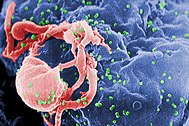HIV
From Wikipedia, the free encyclopedia
This article is about the virus. For the disease, see HIV/AIDS. For other uses, see HIV (disambiguation).
"AIDS virus" redirects here. For the computer virus, see AIDS (computer virus).
| Human immunodeficiency virus | |
|---|---|
 |
|
| Scanning electron micrograph of HIV-1 (in green) budding from cultured lymphocyte. Multiple round bumps on cell surface represent sites of assembly and budding of virions. | |
| Virus classification | |
| Group: | Group VI (ssRNA-RT) |
| Order: | Unassigned |
| Family: | Retroviridae |
| Subfamily: | Orthoretrovirinae |
| Genus: | Lentivirus |
| Species | |
|
|
HIV infects vital cells in the human immune system such as helper T cells (specifically CD4+ T cells), macrophages, and dendritic cells.[4] HIV infection leads to low levels of CD4+ T cells through a number of mechanisms, including apoptosis of uninfected bystander cells,[5] direct viral killing of infected cells, and killing of infected CD4+ T cells by CD8 cytotoxic lymphocytes that recognize infected cells.[6] When CD4+ T cell numbers decline below a critical level, cell-mediated immunity is lost, and the body becomes progressively more susceptible to opportunistic infections.
Tidak ada komentar:
Posting Komentar